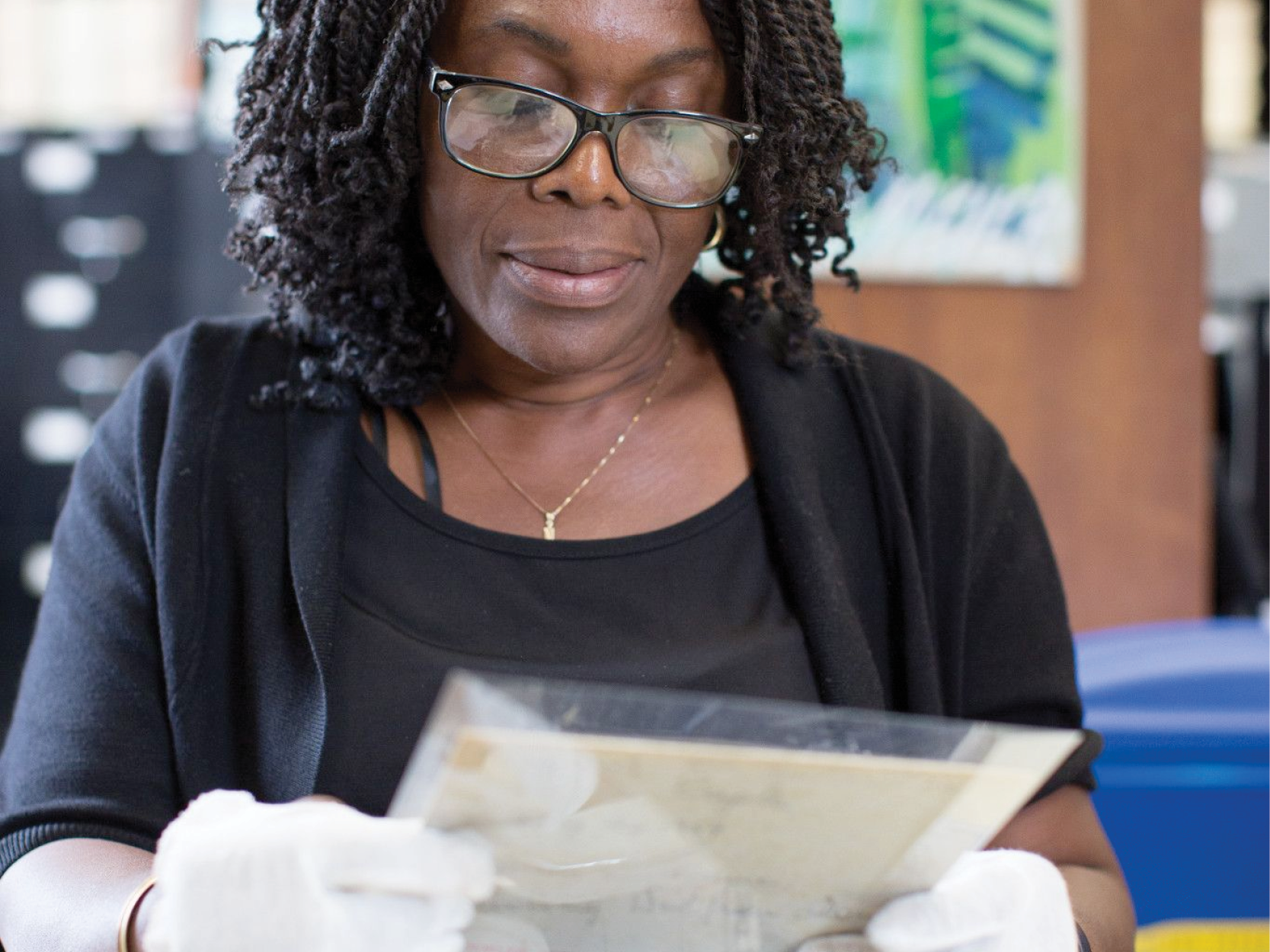
Friday, December 1 is World AIDS Day, a day started by the World Health Organization in 1988 to "show strength and solidarity against HIV stigma and to remember lives lost." The first World AIDS Day was recognized by awareness events (such as condom distributions and fundraisers), discussions among medical experts and human rights advocates, and world leaders calling on the United Nations to increase their efforts to combat the disease ("Bush Is Urged to Be a Leader in the Fight on AIDS," December 2, 1988, New York Times).
The theme for 2023 World AIDS Day is World AIDS Day 35: Remember and Commit. Some events this year in Brooklyn include a Brooklyn Association of Teen Educators Peer Power-up and Teen Town Hall and a Bloodline Dance Theatre performance at Medgar Evers College. The New York City AIDS Memorial is hosting a day of events, including a Queer Soup Night and a candlelight vigil.
In 1993, the Brooklyn Historical Society (BHS) opened a groundbreaking exhibition on HIV and AIDS in Brooklyn: AIDS/Brooklyn. This exhibition aimed to document the crisis in Brooklyn through the material culture, personal narratives, and life histories of those living with HIV/AIDS. This exhibition was a part of BHS's institution-wide efforts to actively respond to contemporary events in Brooklyn through exhibits, collection development, and education. Executive Director, David M. Kahn, spearheaded the project after losing his partner, Ron Wogaman to an AIDS-related illness.

Preparation for the exhibition began in 1991 and included Brooklyn Historical Society Museum Division staff: Ellen Snyder-Grenier (Chief Curator at the start of the project), Daniel Barron (Curator of Collections), and Dwandalyn Reece (Chief Curator starting in November 1992). Robert Rosenberg, a documentary film producer, was hired as project director. Community Advisory and Scholarly Advisory Committees provided guidance throughout the exhibition planning process. The Community Advisory Committee identified individuals and organizations in Brooklyn to reach out to for interviews and donations of materials. The exhibition team printed flyers in English, Spanish, and Haitian Creole and sent them to community and healthcare organizations related to HIV/AIDS issues. Rosenberg and Robert Sember, a New York University doctoral candidate in Performance Studies, conducted the interviews that made up the centerpiece of the exhibition: the voices of people affected by HIV/AIDS.
For views of the exhibition and to hear David Kahn speak about the project, watch this video produced by Gay Men's Health Crisis (GMHC) digitized and available online.

At the time of the exhibition in 1993, the borough of Brooklyn had an estimated 35,000 cases of HIV. Here, as in the rest of the nation, the disease was disproportionately affecting African American, Latino, and gay communities. Brooklyn, however, was experiencing demographic shifts in the spread of AIDS that differed from the considerable high-impact zone of Manhattan. The disease was impacting women and children in Kings County; over 1800 women had HIV/AIDS in 1992, according to the city's AIDS Surveillance Unit ("Chronicling the Spread of AIDS Throughout Brooklyn," May 31, 1992, New York Times).

1993.001, Box 2, Folder 2; Brooklyn Public Library, Center for Brooklyn History.

AIDS/Brooklyn Exhibition records, 1993.001, Box 2, Folder 2;
Brooklyn Public Library, Center for Brooklyn History.
Today, the interviews and materials that were donated for this exhibition are in the AIDS/Brooklyn Exhibition collection here at the Center for Brooklyn History, the successor to the Brooklyn Historical Society. Particularly eye-catching pieces of this collection are protest posters, likely from the United for AIDS Action's AIDS Unity March and Rally in Manhattan in 1992, but possibly from other demonstrations related to ACT UP's "Campaign '92." Campaign '92 was ACT UP's operation to push candidates to come up with AIDS policies and draw voters' attention to the issues. ACT UP's well-known Political Funeral action, where people who lost someone to AIDS threw their loved one[']s['] ashes on the White House lawn, was one of the actions a part of this campaign.
These hand-painted, spray-painted, glued, and collaged pieces represent the anger, grief, fears, and demands of people with HIV/AIDS, the people they loved, and the people who loved them. Each poster is a piece of AIDS advocacy; pushing for better care for people with HIV/AIDS, support for HIV prevention, and government funds for AIDS research and treatment. Below are some of these posters and what they meant in the context of 1992.

This poster has a white background with pieces of paper glued to it. Printed on the paper in the middle of the poster is a black and white photograph of two gravestones next to each other with the words "1992 Class Couple" above it and "The Board of Education's 'Morality' Oath is Killing Students" below it. Logos for ACT UP, WHAM! (Women's Health Action and Mobilization), and Youth Education Life-Line (YELL) are at the bottom of the poster. In 1990, New York City Schools chancellor, Joseph A. Fernandez, announced his plan to distribute condoms in schools. While the medical community, students, and most families supported the plan, some board members and the Catholic Church did not ("New York to Schools:`Use Condoms'", November 3, 1991, Washington Post). While the plan moved forward, two opposing board members insisted AIDS educators in schools sign an "oath" that they would emphasize abstinence over condom use ("2 on Board Defend AIDS Oath," August 29, 1992, New York Times). Ultimately, despite a lawsuit and Fernandez being voted out as chancellor, condoms continued to be distributed in schools.

This poster has a white background with pieces of paper glued to it. Printed on the pieces of paper are a black and white photograph of Bill Clinton with the words "CLINTON" and "Where's your AIDS Plan?" At the bottom of the poster are the logos for ACT UP and Campaña 92 SIDA (Campaign AIDS '92). On the side written in marker are the words: "AIDS WONT WAIT." At the beginning of his presidential campaign, Clinton promised a "Manhattan-type Project" to find a cure for AIDS ("Gays Mobilizing for Clinton As Rights Become an Issue September 28, 1992, Washington Post). But as his campaign progressed, AIDS activists saw that a clear plan for dealing with the AIDS crisis was still missing.

This styrofoam poster board has a large sheet of paper pasted onto it. On the paper is an American flag and instead of 50 stars in the upper lefthand corner, there are skulls symbolizing death. At the bottom of the flag are the words: "BUSH AIDS FLAG." This poster is commenting on George H. W. Bush's response (or lack thereof) to HIV/AIDS during his presidency from 1989-1993. While he signed the Americans with Disabilities Act and the Ryan White CARE Act in 1990, AIDS activists saw him as slow to act. For example, when resigning from the National Commission on AIDS, Magic Johnson said the president had "dropped the ball" on AIDS. By the time Bush left office, HIV infection was the number one cause of death among men aged 25-44 ("‘He Did Not Lead on AIDS’: With Bush, Activists See a Mixed Legacy," December 3, 2018, New York Times).

This poster has a spray-painted Puerto Rican flag with the words "Puerto Rico ¡Sí! / El SIDA ¡No!" ["Puerto Rico Yes! AIDS No!"]. This poster shows Puerto Rican pride and a commitment to fighting AIDS. According to a report published by the National Research Council Panel on Monitoring the Social Impact of the AIDS Epidemic in 1993, Puerto Ricans were the most affected ethnic group by the HIV/AIDS epidemic in New York City (The Social Impact Of AIDS In The United States, 1993). The AIDS/Brooklyn exhibition included oral histories with Puerto Rican individuals and HIV/AIDS awareness materials written in Spanish that were distributed in New York City.

This poster has a white background with pieces of paper glued to it. On the paper is printed in block letters: "Hate is not a 'family value'." In 1992, Christian political organizations, such as Pat Robertson's Christian Coalition, used the concept of "family values" to suppress civil rights gains for the LGBTQ community ("Gays Mobilizing for Clinton As Rights Become an Issue," September 28, 1992, Washington Post). Politicians aligned with the religious right then did not want to provide support for something that was seen as a "gay issue." This poster calls out those politicians for using "family values" as an excuse for homophobia and hate.

This poster is painted to look like a classroom chalkboard. On the "chalkboard" is written: "Q: If 60% of teens are sexually active in high school, and if condoms can stop HIV transmission, how can N.Y. help stop AIDS? A: Distribute condoms." This poster advocates for the distribution of condoms, which protect from HIV and other sexually transmitted infections (STI), in high schools. As mentioned above, HIV/AIDS education in New York City public schools was a heated issue in the early 1990s. Now, the New York City Department of Education requires high schools to make condoms and sexual health information available to students so that it is easily and safely accessible.

This poster has a white background with a drawing of a syringe needle and big red block letters down the right side reading "Clean Needles Save Lives." One of the ways HIV can spread is through intravenous drug use when someone with HIV shares a needle they used with others. This poster advocates for one harm reduction strategy: providing clean, sterile needles so that people using drugs can inject them safely, reducing harm to themselves and others. While needle exchanges remain politically controversial, acceptance and support of Syringe Service Programs (SSPs) has grown.

This poster is the other side of the "Clean Needles Save Lives" poster. It has a white background with pieces of paper glued on it with the words "Ribbons are not enough -- AIDS action now." This ACT UP slogan was a response to the red ribbon promoted by World AIDS Day and worn to spread awareness and show support of people with AIDS. ACT UP activists wanted concrete actions, especially from leaders in government, not just awareness and promises.
These posters are rich historical documents and there is so much more that could be said about their context and meaning. They are an example of how a historical document can teach us more about the issues of the moment in which they were created, but also what has been done and what we still need to do.
This blog post reflects the opinions of the author and does not necessarily represent the views of Brooklyn Public Library.
Post a Comment
While BPL encourages an open forum, posts and comments are moderated by library staff. BPL reserves the right, within its sole discretion, not to post and to remove submissions or comments that are unlawful or violate this policy. While comments will not be edited by BPL personnel, a comment may be deleted if it violates our comment policy.
eNews Signup
Get the latest updates from BPL and be the first to know about new programs, author talks, exciting events and opportunities to support your local library.







